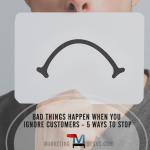6 Ways Your B2B Website Can Become a Lead-Generating Machine
No B2B marketing plan is complete without a website, because a B2B website has the potential to generate more new leads – and convert those leads into customers – than any other marketing channel.
Use These Buyer Stats and Strategies to Turn Your B2B Website into a Lead-Generating Machine
7 in 10 B2B buyers start their research with online search, and 6 in 10 have made up their mind before they ever contact a supplier.
Identify broad and narrow target markets
B2B Website Marketing Task #1: define your target markets.
You can’t attract the leads most likely to buy from your business unless you know who they are, and what they want when they look for a business like yours. You can improve the ability your B2B website has to attract genuine leads when you add more specific content – content that would resound with your most “ideal” buyer types.
- From your general, or broader target markets, create buyer personas made up of general shared characteristics (industries, business types, job titles, values, priorities, etc.)
- Look for niche markets, such as under-served industries, business types or even business or order size
- Create a composite listing of the traits which would characterize your ideal client type/s
Make it as easy as possible for them to discover what they would most want to know
B2B Website Marketing Task #2: make it as easy as possible for people to find you.
For each of the target markets, niche markets and ideal client types you identified, surmise the types of:
- Keywords they would be likely to use in an online search
- Points of competitive advantage your business possesses they may be most likely to appreciate
These keywords and phrases should become part of your optimization strategy (see #4 below); and the points of competitive advantage you identified should be infused into your website’s home and landing pages, as well as your email newsletters, social media profiles and posts and other marketing materials.
Make it as easy as possible for a lead to convert to a customer on your B2B website
B2B Website Marketing Task #3: make it as easy as possible for people to buy from you.
- Contact forms should be built in to your website’s architecture so that every page provides a way for leads to: subscribe to updates, request information or apply for a quote
- Compare and contrast; you don’t have to name names, but your web content should feature graphic illustrations, mathematical comparisons and other demonstrations of how choosing your business benefits your customers in overall value (time, money, service, fees, etc.)
- Differentiate your business; keywords – which may be identical to those of your competitors – may bring leads to your websites; however, it is your unique selling points or points of differentiation that will cause them to choose your business over those of your competitors
- Customer reviews and testimonials are persuasive with all buyer types; use them on social networks, advertising, email newsletters and other marketing channels to help pull leads to your site, and infuse testimonials and quotes throughout your web copy and in call-outs in order to help persuade buyers who are on the fence or comparing you to competitors
Make sure your B2B website is optimized for online search
Every page of your content should have unique content that is (first and foremost) of value and interest to your target markets, and which is optimized in both on-page content and unseen content (such as html tags, page titles, meta tags, alternative text for images or “alt” text, etc.) for online search, so that it can “pull” members of your target markets to your website:
- Identify keywords and phrases your broad and narrow markets would be most likely to use; these keywords should be used throughout your website, blog, email and social media content
- Every page of your website should have a unique title and a unique meta description which includes one or more of the keywords or phrases members of your target markets would be likely to use when looking for a business or services like yours
- On-page headlines – the section labels which stand out in web or blog copy in “H” tags – should contain unique keywords / phrases and variations, so that your site does not become keyword stuffed or repetitive to site visitors
- Within on-page content, use keywords or phrases as anchor text, becoming the text that is an active link to other pages in your site (or in links back to your website from your blog, external sites and social networks)
- On page content should include keywords or phrases and their variations, but not be overly “stuffed” with keywords (search algorithms are now designed to detect this and may penalize your site if they find keyword-stuffed content on it). When in doubt, writing for “real people” who represent your target markets and will read the page should trump keyword use!
Keep adding website content on a regular basis
B2B Website Marketing Task #4: Lather, rinse, repeat.
By consistently adding quality, optimized content to your website, blog and email newsletters, you provide search engines with the “fresh” content algorithms are programmed to detect.
Push your website content so it can pull even more leads in
New content can help “pull” online searchers to your website and blog, but you can increase its power to help you attract leads and convert customers by “pushing” content out. New content added to your blog or website should be “pushed” out using:
- Social network and group status updates (posting to Facebook, Google+, LinkedIn, Pinterest and Twitter)
- Content curation sites where content is accumulated by topic or tag (Scoop.It, Paper.li, Tumblr, and Stumble Upon are just a few examples of content curation sites)




